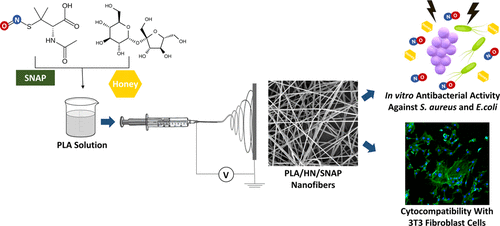当前位置:
X-MOL 学术
›
ACS Biomater. Sci. Eng.
›
论文详情
Our official English website, www.x-mol.net, welcomes your feedback! (Note: you will need to create a separate account there.)
Synergistic Approach to Develop Antibacterial Electrospun Scaffolds Using Honey and S-Nitroso-N-acetyl Penicillamine
ACS Biomaterials Science & Engineering ( IF 5.8 ) Pub Date : 2021-01-04 , DOI: 10.1021/acsbiomaterials.0c01411 Sama Ghalei 1 , Jianwen Li 1 , Megan Douglass 1 , Mark Garren 1 , Hitesh Handa 1
ACS Biomaterials Science & Engineering ( IF 5.8 ) Pub Date : 2021-01-04 , DOI: 10.1021/acsbiomaterials.0c01411 Sama Ghalei 1 , Jianwen Li 1 , Megan Douglass 1 , Mark Garren 1 , Hitesh Handa 1
Affiliation

|
Bacterial infections have been increasingly recognized as the major reason for the failure of tissue engineering scaffolds. Therefore, there is a need for novel and multifunctional biomaterials that not only enhance tissue regeneration but also can combat infections. An antibacterial and bioactive scaffold was fabricated in this study by incorporation of honey and a nitric oxide (NO) donor, S-nitroso-N-acetyl-penicillamine (SNAP), into polylactic acid (PLA) nanofibers using a single-jet electrospinning method. The morphology of the prepared nanofibers was observed using a scanning electron microscope. PLA/honey/SNAP (PLA/HN/SNAP) nanofibers had an average diameter of 624.92 ± 137.69 nm and showed a sustained release of NO for 48 h. The scaffolds were characterized for their chemical composition via Fourier-transform infrared spectroscopy. Moreover, the tensile properties of nanofibers along with their wettability, water retention ability, and water vapor transmission rate were evaluated. The results of antibacterial studies revealed that the synergistic combination of honey and SNAP significantly reduced the viability of Gram positive Staphylococcus aureus and Gram negative Escherichia coli. In addition, qualitative and quantitative 3T3 fibroblast cell culturing experiments proved that the PLA/HN/SNAP scaffolds supported better cell attachment and proliferation compared to PLA. The promising results obtained in this study indicate that PLA/HN/SNAP nanofibrous scaffolds have great potential for tissue engineering applications.
中文翻译:

用蜂蜜和S-亚硝基-N-乙酰青霉素胺开发抗菌电纺支架的协同方法
细菌感染已被越来越多地认为是组织工程支架失效的主要原因。因此,需要不仅增强组织再生而且还可以抵抗感染的新型多功能生物材料。在这项研究中,通过掺入蜂蜜和一氧化氮(NO)供体S-亚硝基-N制备了一种抗菌和生物活性支架单喷静电纺丝法将乙酰乙酰青霉胺(SNAP)制成聚乳酸(PLA)纳米纤维。使用扫描电子显微镜观察所制备的纳米纤维的形态。PLA /蜂蜜/ SNAP(PLA / HN / SNAP)纳米纤维的平均直径为624.92±137.69 nm,并显示NO持续释放48小时。通过傅立叶变换红外光谱对支架的化学组成进行表征。此外,评估了纳米纤维的拉伸性能以及其润湿性,保水能力和水蒸气透过率。抗菌研究的结果表明,蜂蜜和SNAP的协同作用显着降低了革兰氏阳性金黄色葡萄球菌和革兰氏阴性大肠杆菌的生存能力。此外,定性和定量的3T3成纤维细胞培养实验证明,与PLA相比,PLA / HN / SNAP支架支持更好的细胞附着和增殖。在这项研究中获得的有希望的结果表明PLA / HN / SNAP纳米纤维支架在组织工程应用中具有巨大的潜力。
更新日期:2021-02-08
中文翻译:

用蜂蜜和S-亚硝基-N-乙酰青霉素胺开发抗菌电纺支架的协同方法
细菌感染已被越来越多地认为是组织工程支架失效的主要原因。因此,需要不仅增强组织再生而且还可以抵抗感染的新型多功能生物材料。在这项研究中,通过掺入蜂蜜和一氧化氮(NO)供体S-亚硝基-N制备了一种抗菌和生物活性支架单喷静电纺丝法将乙酰乙酰青霉胺(SNAP)制成聚乳酸(PLA)纳米纤维。使用扫描电子显微镜观察所制备的纳米纤维的形态。PLA /蜂蜜/ SNAP(PLA / HN / SNAP)纳米纤维的平均直径为624.92±137.69 nm,并显示NO持续释放48小时。通过傅立叶变换红外光谱对支架的化学组成进行表征。此外,评估了纳米纤维的拉伸性能以及其润湿性,保水能力和水蒸气透过率。抗菌研究的结果表明,蜂蜜和SNAP的协同作用显着降低了革兰氏阳性金黄色葡萄球菌和革兰氏阴性大肠杆菌的生存能力。此外,定性和定量的3T3成纤维细胞培养实验证明,与PLA相比,PLA / HN / SNAP支架支持更好的细胞附着和增殖。在这项研究中获得的有希望的结果表明PLA / HN / SNAP纳米纤维支架在组织工程应用中具有巨大的潜力。

























 京公网安备 11010802027423号
京公网安备 11010802027423号